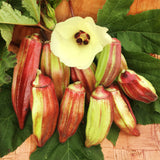Hill Country Red Okra
Abelmoschus esculentus
These plump, red and green pods have a rich, delicious okra flavor. In my field, they grew to above average heights of 8-feet tall on thick, deep-red stems, and produced for months! Hill Country Red Okra is said to have originated in the eastern portion of the mostly limestone Edwards Plateau in west-central Texas—also known as Texas Hill Country. This area has a large German population and influence, which meant they opposed secession from the Union during the Civil War, and also meant introducing the accordion to Tejano music. Okra is probably from West Africa, though some claim Ethiopia as the origin. Many believe enslaved Africans hid okra seeds in their hair on the forced journey across the Atlantic. Certainly, this crop is a taste of home for people of the African Diaspora. My partner Chris (another Truelove Seeds farmer based at the Sankofa Farm at Bartram's Garden) is from Mississippi and is an okra fanatic. This is his favorite variety hands-down, but cannot commit to growing only one type, so I isolated this crop to produce true seed.
Days to maturity: 60-70
Seeds per pack: 40
Germination rate: 93% on 10/01/2025
Planting / harvesting notes
Sow seeds of this heat-loving plant indoors 2-3 weeks before transplanting, which should happen several weeks after the last frost, or when soil temperatures stay above 65 degrees Fahrenheit. Soak seeds overnight for quicker germination, and plant 3/4" deep. Space 18" in rows 12-18" apart. Beds should be at least 3' apart as plants tend to bush out widely. Okra likes fertile, well-drained soil with added compost.
We harvest and eat this okra when the pods are 2-3" long and still tender. You can harvest it up to 5-6", but may find them a bit woody. Can be eaten red or green! When growing new varieties of okra, we encourage harvesting at all different stages until you get a sense of the best size for eating. We even eat them raw in the field as a test!
Seed keeping notes
Okra is insect pollinated. Isolate different okra varieties by at least 1/8th of a mile (or up to 1/2 mile if you are truly concerned about seed purity) to avoid unwanted cross pollination. Allow pods to grow large and turn brown and woody (your neighbors may look at you funny). When you can hear the seeds rattle, harvest the pod and allow it to dry further on trays in the sun in a dry place. Remove seeds and use breath, wind, or fans to remove bits of chaff.





